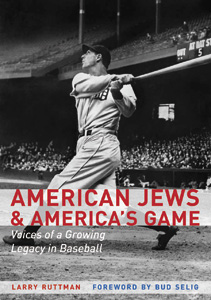‘American Jews & America’s Game’ offers interviews with key baseball figures
Published July 3, 2013
Larry Ruttman has been a Boston attorney for more than 50 years. He also produces and hosts a television and interview show in his hometown of Brookline, Mass. Several years ago he taught an adult education course on the art of the interview using as guides his own previously published “Voices of Brookline,” and Studs Terkel’s “Working.” He taught his students through back-and-forth dialogues how to produce first-person interviews that turned conversations into a stories that were livelier than monologues.
Ruttman had always wanted to write a book about the impact of Jews on the history of baseball for two reasons. He has had a lifelong love for the game, and although he has been ritually nonobservant since his bar mitzvah, he has always been proud of his Jewish heritage. He felt that he could turn interviews with an assortment of people connected with baseball talking personally about their experiences and thoughts into a book on baseball, Judaism and America. The result was “American Jews & America’s Game: Voices of a Growing Legacy in Baseball” (University of Nebraska Press, $34.95, 510 pages).
Ruttman attempted to interview Jews who had left a mark on America’s pastime and arranged his slightly more than 40 chapter-length profiles by decade, from the 1920s to the present. With two notable exceptions, Ruttman was able to personally interview many well-known Jewish players including Al Rosen, Art Shamsky, Ken Holtzman, Ron Blomberg, Gabe Kapler, Kevin Youkalis, Ian Kinsler, Ryan Braun and Shawn Green.
Unfortunately, the exceptions were the only two Jewish players in the Baseball Hall of Fame, Hank Greenberg and Sandy Koufax. Because Greenberg passed away in 1986, Ruttman had to interview his two children Steve and Alva, his biographer Ira Berkow, Aviva Kempner, creator of a very successful documentary film on Hank’s life, and fellow Hall of Famer Ralph Kiner, Greenberg’s teammate on the Pittsburgh Pirates in 1947, Greenberg’s last year in the big leagues.
The other noted exclusion was Sandy Koufax, baseball’s Jewish superstar, especially during the 1960s. At the age of 78, Koufax is still notoriously reclusive and refused Rutman’s request. In order to obtain some semblance of Koufax’s feelings about the impact of Jews on baseball’s history, Ruttman was forced to obtain this information from Koufax’s contemporaries.
In addition to these players, Ruttman also interviewed a number of important and well-known non-players. This list includes prolific baseball author Roger Kahn; the late Marvin Miller, former executive director of the Major League Baseball Players Association; “Bud” Selig; the Commissioner of Major League Baseball; Theo Epstein, the youngest general manager in major league baseball history; Randy Levine, President of the New York Yankees; and Steve Steinberg, owner of the Tampa Bay Rays.
It took Ruttman from 2007 to 2013 to conduct these interviews, which took place in a variety of locales including Massachusetts, Florida, California, Arizona, New York and Israel. Everyone interviewed told Ruttman about his growing up Jewish, and dealing with Jewish identity, anti-Semitism and religious observance.
Ruttman’s book has a number of positives. It is well written and the reader will easily identify the people the author has interviewed and will likely be interested in how each has responded to Ruttman’s questions.
The elimination of two flaws, however, would have made this a much better book. First, the book tends to be too wordy and repetitive. Since many of Ruttman’s interviewees generally told him the same story, the author could have paraphrased the responses rather than publishing them verbatim. For example, nearly all of the respondents told him that, directly or indirectly, baseball was largely responsible for enabling the Jewish immigrants of the early 1900s to assimilate more easily. This is a well-known fact and Ruttman could have been more concise in discussing this topic.
A far more serious flaw was that Ruttman began with a hypothesis he wanted to prove: that Jewish Americans involved in baseball became successful because of their Jewish values. To give him his due, most of those interviewed did agree. There were some dissenters, however, who stated that there was simply no connection between Jewish values and their success. Regardless what the interviewee said, however, Ruttman tried to draw out their support for his theory. Simply put, Ruttman structured his questions so that the responses were generally those he wanted, which resulted in minimizing the value of the answers. The most egregious example was the interview of former Congressman Barney Frank who represented Ruttman’s congressional district. In response to Ruttman’s question about who Frank would choose as the most influential Jews connected with baseball, Frank indicated he had no idea. Not content with this answer, Ruttman prodded further and suggested that perhaps it might be Baseball Commissioner “Bud” Selig. A perturbed Frank countered. “You have asked me a question, and I have given you the answer. If you don’t like my answer, don’t suggest an answer—that’s not good journalism.”
If the reader can overlook these flaws, he or she will find the book interesting primarily because most of the interview subjects are familiar figures both on and off the baseball diamond.















